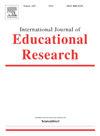Research on the influence of teachers’ ICT Capacity on classroom teaching quality: An intermediary model based on self-efficacy
IF 2.5
3区 教育学
Q1 EDUCATION & EDUCATIONAL RESEARCH
引用次数: 0
Abstract
As the core participants and implementers of the digital transformation in education, enhancing teachers’ proficiency in Information and Communication Technology (ICT) emerges as a crucial lever for catalyzing educational reform. Based on the technology integration theory and constructivism theory, using the data from the Teaching and Learning International Survey (TALIS) as the research sample, the OLS multiple regression model, Shapley value decomposition method, mediation effect model, quantile regression model, and threshold regression model were used to empirically examine the empowerment effect, mechanism effect, heterogeneity effect, and threshold effect of teachers’ ICT capacity on classroom teaching quality. The study found that, compared with OECD countries, there is much room for improvement in the ICT capacity of teachers in Shanghai, China, where teachers receive adequate ICT training, but there is a serious lack of digital technology literacy among teachers, and the phenomenon of “acceptance in reason but detachment in practice” is significant. The ability of teachers to utilize information and communication technology (ICT) significantly influences classroom teaching quality, with teachers’ self-efficacy playing a partially mediating role. Enhancing teachers’ ICT capacity has the strongest impact on the “cognitive mobilization” dimension, while its effect on the “classroom management” dimension is comparatively weaker. Moreover, the empowering effect of information and communication technology increases as the quality of teachers' teaching improves, and to some extent, there is a “Matthew effect” that leads to a widening of the gap in the quality of classroom teaching. Furthermore, teachers’ ICT capacity in the process of promoting the improvement of classroom teaching quality is characterized by the double-threshold effect of “stair-step rise”. With the improvement of teachers’ ICT capacity, its effect on the improvement of classroom teaching quality shows marginal incremental characteristics, breaking the “ceiling effect”. Based on these findings, recommendations include enhancing the multi-principal ecosystem of digital education, developing a digital profile of teachers’ teaching, providing supportive resources in a hierarchical and categorized manner, and fostering the establishment of a teacher-learning community.
教师ICT能力对课堂教学质量的影响研究:基于自我效能感的中介模型
教师作为教育数字化转型的核心参与者和实施者,提高教师的信息通信技术水平成为推动教育改革的重要杠杆。基于技术整合理论和建构主义理论,以《教与学国际调查》(TALIS)数据为研究样本,运用OLS多元回归模型、Shapley值分解法、中介效应模型、分位数回归模型和阈值回归模型,实证检验教师ICT能力对课堂教学质量的赋权效应、机制效应、异质性效应和阈值效应。研究发现,与经合组织国家相比,中国上海教师的ICT能力有很大的提升空间,教师接受了充分的ICT培训,但教师的数字技术素养严重不足,“理性接受,实践脱离”现象明显。教师利用信息通信技术的能力显著影响课堂教学质量,教师自我效能感在其中起部分中介作用。教师ICT能力提升对“认知动员”维度的影响最大,而对“课堂管理”维度的影响相对较弱。此外,随着教师教学质量的提高,信息通信技术的赋能效应也在增强,在一定程度上存在“马太效应”,导致课堂教学质量差距的扩大。此外,教师ICT能力在促进课堂教学质量提升的过程中,呈现出“阶梯式上升”的双门槛效应。随着教师ICT能力的提升,其对课堂教学质量提升的作用呈现边际增量特征,打破了“天花板效应”。基于这些发现,建议包括加强数字教育的多校长生态系统,建立教师教学的数字档案,以分层和分类的方式提供支持资源,以及促进建立教师学习社区。
本文章由计算机程序翻译,如有差异,请以英文原文为准。
求助全文
约1分钟内获得全文
求助全文
来源期刊

International Journal of Educational Research
EDUCATION & EDUCATIONAL RESEARCH-
CiteScore
6.20
自引率
3.10%
发文量
141
审稿时长
21 days
期刊介绍:
The International Journal of Educational Research publishes regular papers and special issues on specific topics of interest to international audiences of educational researchers. Examples of recent Special Issues published in the journal illustrate the breadth of topics that have be included in the journal: Students Perspectives on Learning Environments, Social, Motivational and Emotional Aspects of Learning Disabilities, Epistemological Beliefs and Domain, Analyzing Mathematics Classroom Cultures and Practices, and Music Education: A site for collaborative creativity.
 求助内容:
求助内容: 应助结果提醒方式:
应助结果提醒方式:


